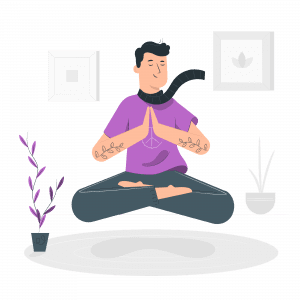Introduction
Welcome to a world where nurturing your spiritual side is as important as meeting your daily obligations. In our guide, “Spiritual Wellness Activities: 10 Ways to Connect with Your Inner Self,” we focus on the crucial role these activities play in enhancing your overall well-being. Spiritual wellness goes beyond our physical needs and mental tasks, tapping into the essence of who we are and what truly brings us peace and fulfillment.
In the hustle of everyday life, it’s easy to lose touch with our inner selves. That’s where spiritual wellness activities step in. These practices, ranging from meditation to nature walks, are powerful tools for self-discovery and inner tranquility. They help us slow down, reflect, and connect with aspects of our lives that often go unnoticed in our busy schedules.
Through this guide, you’ll discover how integrating these activities into your routine can bring a sense of balance and deeper meaning to your life. Each activity is a path to rediscovering what makes you feel whole, centered, and connected, both to yourself and the world around you.
Defining Spiritual Wellness
Spiritual wellness might seem like a broad concept, but at its heart, it’s about finding a sense of purpose and meaning in life that goes beyond the material and mundane. It’s a personal journey, unique to each individual, involving the exploration and establishment of one’s values, beliefs, and purpose. This aspect of wellness is about more than just religious or spiritual practices; it encompasses the broader quest for peace, understanding, and harmony within oneself and with the universe.
At its core, spiritual wellness prompts introspection and self-exploration. It’s about asking the big questions: Who am I? What is my purpose? What makes life meaningful? It’s also about finding your place in the grand scheme of things and understanding how you relate to others and the world.
This exploration leads to a greater sense of well-being. When we are spiritually well, we feel more connected, not just to others, but to the world as a whole. This connection brings a sense of peace and contentment, which has profound implications for our overall health. Research has shown that a strong sense of spiritual wellness can contribute to reduced stress, better health outcomes, and improved emotional health. It can enhance resilience, giving us the strength to face life’s challenges with a more balanced and grounded perspective.
In essence, spiritual wellness is about cultivating a deep and meaningful relationship with yourself and the world around you. It’s about living a life that is consistent with your values and beliefs, and in doing so, finding a sense of fulfillment and contentment that transcends the physical and the immediate.
Also Read: 9-Dimensions of Wellness
Activity 1: Meditation and Mindfulness in Spiritual Wellness Activities

Meditation and mindfulness form a crucial part of spiritual wellness activities, focusing on presence and connection between mind, body, and spirit. The American Psychological Association highlights how mindfulness meditation significantly boosts mental health, reinforcing its importance in a spiritual wellness journey.
Integrating Meditation and Mindfulness into Your Spiritual Wellness Routine:
-
- Begin Gradually: Initiate your practice with short daily sessions, gently extending the duration as you grow more accustomed.
- Establish a Serene Space: Choose a quiet area dedicated to your meditation, conducive to uninterrupted focus.
- Consistency is Key: Set a regular time for these practices, making them a habitual part of your spiritual wellness activities.
- Guided Meditation for Starters: If new to meditation, guided sessions can offer valuable support and direction.
- Breath Focus: Using your breath as a focal point is a fundamental technique in meditation and mindfulness, aiding in anchoring you to the present.
- Daily Mindfulness: Integrate mindfulness into everyday activities, fully engaging with each moment, a practice that enhances your overall spiritual wellness.
By embedding meditation and mindfulness in your spiritual wellness activities, you’re likely to experience heightened inner peace, improved focus, and a deeper connection with your inner self, which are vital components of spiritual wellness.
Activity 2: Yoga and Physical Movement in Spiritual Wellness Activities

Yoga and physical movement are integral parts of spiritual wellness activities, serving as bridges that connect the physical body to the mind and spirit. These practices are about more than just physical fitness; they offer a pathway to inner tranquility and self-awareness.
Embracing Yoga and Physical Movement in Your Spiritual Wellness Journey:
-
- Choose a Style That Resonates: From gentle Hatha to more dynamic Vinyasa, find a yoga style that aligns with your spiritual and physical needs.
- Create a Dedicated Practice Space: Whether at home or in a class, having a designated area for yoga enhances your focus and intention.
- Listen to Your Body: Yoga is about harmony, not competition. Pay attention to your body’s limits and move in ways that feel nourishing and restorative.
- Combine with Breathwork: Integrating breathwork or pranayama with physical movement in yoga deepens the spiritual experience, fostering a greater sense of inner balance.
- Incorporate Mindfulness: Be fully present in each movement and pose, observing the sensations and emotions that arise, which enriches your spiritual connection.
- Regular Practice: Consistency in yoga and physical movement is key to unlocking their full spiritual benefits, making them an essential part of your spiritual wellness activities.
Incorporating yoga and physical movement into your routine not only strengthens your body but also calms your mind and nurtures your spirit, making them powerful tools in your spiritual wellness arsenal.
Also Read: 21- Day Yoga Challenge
Activity 3: Nature Walks and Outdoor Meditation in Spiritual Wellness Activities

Nature walks and outdoor meditation hold a special place in spiritual wellness activities, offering a unique way to connect with the natural world and, in turn, with our deeper selves. Immersing in nature can lead to profound spiritual growth and a sense of interconnectedness with life.
Benefits and Practices of Nature Walks and Outdoor Meditation:
-
- Deepened Connection with Nature: Spending time in nature, whether it’s a serene forest, a tranquil beach, or a vibrant park, can heighten your sense of belonging in the world and deepen your spiritual connection.
- Meditation in Nature: Outdoor meditation combines the calming effects of meditation with the restorative power of nature. Find a peaceful spot in nature and meditate to the natural symphony of sounds around you.
- Mindful Nature Walks: Practice mindfulness during your walks by fully immersing yourself in the experience. Notice the colors, textures, sounds, and scents around you, allowing them to anchor you in the present moment.
- Reflective Practices: Use time in nature for reflection. You might ponder life’s mysteries, contemplate personal growth, or simply revel in the beauty of the natural world.
- Gratitude Moments: Nature walks offer the perfect opportunity to practice gratitude. Take moments to appreciate the beauty and intricacy of the natural world, fostering a deeper appreciation for life.
Incorporating nature walks and outdoor meditation into your spiritual wellness activities provides a powerful way to ground yourself, find peace, and reconnect with the fundamental elements of life. These practices encourage a harmony that resonates not just within yourself but with the universe as a whole.
Activity 4: Journaling for Self-Reflection in Spiritual Wellness Activities

Journaling is a key practice in spiritual wellness activities, offering a private space for self-reflection and personal insight. It’s a tool for delving into your thoughts and feelings, allowing for a deeper understanding of your spiritual journey.
Facilitating Self-Discovery and Spiritual Growth Through Journaling:
-
- Reflective Writing: Journaling helps in untangling complex thoughts and emotions. It provides clarity, allowing you to explore your beliefs, goals, and the aspects of life that give you meaning.
- Tracking Spiritual Growth: Regular journal entries can serve as milestones of your spiritual journey, helping you see how far you’ve come and where you’re headed.
- Prompts to Kickstart Journaling: If you’re unsure where to begin, prompts can guide your writing. Consider questions like, “What am I most grateful for today?” or “What lesson did I learn this week that helped me grow?”
- Free Writing: Sometimes, letting your thoughts flow without structure can lead to profound insights. Free writing encourages a stream of consciousness that can uncover hidden feelings and aspirations.
- Combining Journaling with Meditation: After meditating, take some time to journal. This can be an excellent way to process insights or feelings that arose during meditation.
Incorporating journaling into your spiritual wellness activities offers a powerful means for introspection and personal growth. It’s a practice that nurtures a deeper connection with the inner self, fostering spiritual understanding and well-being.
Activity 5: Gratitude Practice in Spiritual Wellness Activities

Gratitude practice is a transformative element in spiritual wellness activities. It revolves around acknowledging and appreciating the positives in life, big and small, leading to a profound impact on one’s spiritual and overall well-being.
The Role of Gratitude in Spiritual Wellness:
-
- Enhancing Positivity and Perspective: Regular gratitude practice shifts focus from what’s lacking to what’s abundant in life. This shift fosters positivity, reduces stress, and cultivates a more optimistic outlook, which is crucial for spiritual wellness.
- Deepening Connections: Expressing gratitude strengthens relationships, creating a deeper sense of connection and belonging, both key aspects of spiritual health.
Starting a Gratitude Practice:
-
- Gratitude Journal: One effective way to practice gratitude is through a journal. Dedicate a few minutes each day to write down things you are thankful for. These could range from significant life events to simple pleasures.
- Mindful Acknowledgment: Make it a habit to acknowledge and appreciate moments of joy and kindness throughout your day. It could be as simple as a warm cup of coffee, a helpful colleague, or a beautiful sunset.
- Gratitude Reflections: Regularly reflect on the broader aspects of your life you’re grateful for – your health, opportunities, relationships, or personal growth.
- Expressing Gratitude to Others: Directly express your gratitude to people in your life. This can strengthen bonds and spread positivity.
By incorporating gratitude practice into your daily routine, you’re likely to experience a deeper sense of contentment, a more profound appreciation for life, and enhanced spiritual wellness. Gratitude turns ordinary moments into blessings, reminding us of the abundance that life offers.
Read Further: 30-Day Gratitude Challenge
Activity 6: Volunteering and Acts of Kindness in Spiritual Wellness Activities

Volunteering and practicing acts of kindness are deeply fulfilling activities that play a significant role in enhancing spiritual wellness. Altruistic actions not only benefit others but also enrich your own spiritual journey by fostering a sense of connection and purpose.
The Spiritual Fulfillment of Altruism:
-
- Deepened Sense of Purpose: Engaging in acts of kindness and volunteering can give you a profound sense of purpose and fulfillment. It reinforces the idea that your actions can have a positive impact on the world.
- Strengthened Community Bonds: These activities foster a feeling of interconnectedness. Helping others can break down barriers and build stronger, more compassionate communities.
Ways to Volunteer and Practice Kindness:
-
- Find Local Opportunities: Look for volunteer opportunities in your local community. Whether it’s helping at a food bank, tutoring children, or participating in environmental clean-ups, find something that resonates with your values.
- Small Acts of Kindness: Volunteering doesn’t have to be a grand gesture. Small, everyday acts of kindness, like helping a neighbor or simply offering a smile, can be incredibly impactful.
- Corporate Volunteering: If you’re employed, explore if your workplace has corporate volunteering programs. This can also be a great way to connect with colleagues on a deeper level.
- Virtual Volunteering: If physical volunteering is challenging, consider virtual options like offering online support or skills-based volunteering.
Incorporating volunteering and acts of kindness into your spiritual wellness activities can be immensely rewarding. It allows you to step outside yourself, contribute to the greater good, and in the process, find deeper spiritual satisfaction and connection.
Activity 7: Creative Expression in Spiritual Wellness Activities

Creative expression, encompassing activities like painting, music, writing, or dance, holds a special place in spiritual wellness activities. These forms of creativity are not just hobbies or pastimes; they are profound practices for exploring and expressing the inner self, offering a unique path to spiritual enrichment.
Creative Activities as Spiritual Practices:
-
- Channeling Emotions: Engaging in creative activities provides an outlet for emotions, thoughts, and experiences that might be hard to express verbally. This process can lead to significant self-discovery and emotional release.
- Meditative State: Activities like painting or playing music can induce a meditative state, where you’re fully immersed in the moment. This focus and immersion bring a sense of calm and connectedness, akin to meditation.
- Self-Expression and Identity: Creative expression is a powerful tool for exploring and asserting personal identity. It can be a journey of self-acceptance and understanding, key components of spiritual wellness.
Exploring Different Forms of Creative Expression:
-
- Try Various Arts: Experiment with different creative mediums. You might find spiritual connection through writing poetry, crafting, or playing an instrument. Each form offers a unique way to connect with your inner self.
- Join Classes or Workshops: Participating in classes or workshops can be a way to explore new forms of creative expression under guidance. It’s also an opportunity to connect with others who share similar interests.
- Integrate Creativity in Daily Life: Find ways to incorporate creativity into your everyday activities. This could be doodling, creating a vision board, or simply experimenting with creative cooking.
In your spiritual wellness journey, allowing space for creative expression can open new avenues for personal growth and spiritual fulfillment. Whether it’s through a canvas, a melody, or a written word, creativity offers a profound way to explore and express your spiritual self.
Activity 8: Reading and Learning in Spiritual Wellness Activities

Incorporating reading and learning, especially of spiritual and inspirational literature, is a meaningful activity in the realm of spiritual wellness. Engaging with thought-provoking texts offers not just knowledge, but also a way to reflect on and deepen your spiritual understanding.
The Role of Reading in Spiritual Wellness:
-
- Broadening Perspectives: Reading books on spirituality, philosophy, or personal growth can open your mind to new ideas, beliefs, and worldviews. This broadened perspective can lead to greater empathy and a deeper understanding of the spiritual journey.
- Inspiration and Motivation: Inspirational literature can ignite a sense of hope, resilience, and motivation. It can provide comfort during challenging times and encourage you to persevere on your spiritual path.
- Personal Reflection: Reading often prompts introspection. It can resonate with your experiences, validating your feelings and encouraging self-discovery.
Recommended Books and Resources for Spiritual Growth:
-
- “The Power of Now” by Eckhart Tolle: A guide to spiritual enlightenment, emphasizing the importance of living in the present moment.
- “The Seven Spiritual Laws of Success” by Deepak Chopra: This book blends spirituality and practicality, offering steps to achieve success without losing sight of personal and spiritual growth.
- “The Alchemist” by Paulo Coelho: A fictional narrative full of symbolism and life lessons, this book is about following your dreams and listening to your heart.
- “Siddhartha” by Hermann Hesse: A novel that explores the spiritual journey of self-discovery, set in the time of Gautama Buddha.
- “The Art of Happiness” by Dalai Lama: This book explores the concept of happiness as a state of mind and how to achieve it through compassion and self-reflection.
- Online Resources: Look for podcasts, online courses, and webinars focused on spiritual growth and wellness.
Incorporating reading and learning into your spiritual wellness activities can be incredibly enriching. It provides nourishment for the mind and soul, helping you grow, evolve, and maintain a balanced spiritual life.
Activity 9: Mindful Eating and Conscious Living in Spiritual Wellness Activities

Mindful eating and conscious living are integral to spiritual wellness activities, offering a way to bring mindfulness into everyday life. These practices are about being fully present and intentional with your actions, especially with routine tasks like eating.
Embracing Mindfulness in Daily Activities:
-
- Mindful Eating: This involves paying close attention to the experience of eating. Notice the flavors, textures, and sensations as you eat. It’s not just about what you eat, but how you eat – slowly, appreciatively, and without distraction.
- Conscious Choices: Make deliberate choices about what you eat, considering the health benefits and where the food comes from. This awareness can lead to a deeper appreciation and a more ethical, health-conscious approach to eating.
Practicing Conscious Living:
-
- Present Moment Awareness: Try to stay fully engaged in whatever you’re doing, whether it’s working, conversing, or even doing chores. Conscious living is about experiencing each moment fully, not just mechanically going through the motions.
- Environmental Consciousness: Be aware of your impact on the environment. Simple acts like recycling, conserving water, or using eco-friendly products contribute to a more conscious, sustainable lifestyle.
- Reflection and Meditation: Regular reflection and meditation can enhance your ability to live consciously. They help in developing an acute awareness of your thoughts, actions, and their impact on your surroundings.
By incorporating mindful eating and conscious living into your spiritual wellness activities, you not only enhance your physical health but also cultivate a deeper connection with yourself and the world around you. These practices foster a sense of presence, gratitude, and responsibility, enriching your spiritual journey.
Activity 10: Connecting with Community in Spiritual Wellness Activities

In the pursuit of spiritual wellness, connecting with a community can be profoundly enriching. It’s about sharing experiences, learning from others, and feeling a sense of belonging. Being part of a community brings a new dimension to spiritual growth, one that emphasizes interconnectedness and mutual support.
The Role of Community in Spiritual Wellness:
-
- Shared Experiences: Engaging with a community offers the chance to share experiences, insights, and support. This can deepen your understanding and provide different perspectives on spiritual matters.
- Sense of Belonging: Being part of a group can foster a sense of belonging and connectedness, which is crucial for emotional and spiritual well-being.
Ideas for Community Involvement and Group Activities:
-
- Join or Form a Spiritual Group: Look for local groups that focus on spiritual development, meditation, or yoga. You can also start your own group with like-minded individuals.
- Attend Workshops and Retreats: Participating in spiritual workshops or retreats can be a way to meet others on a similar path and deepen your spiritual practices.
- Volunteer Together: Volunteering as a group activity can be a fulfilling way to give back while strengthening community bonds.
- Group Meditation or Yoga Classes: Regular group meditation or yoga sessions can create a shared space for spiritual practice and connection.
- Discussion Circles: Arrange regular meetings where you discuss spiritual topics, books, or share personal experiences in a safe and open environment.
Engaging in spiritual wellness activities within a community setting offers the opportunity to grow together, support one another, and share in the spiritual journey. It emphasizes the idea that while spiritual wellness is a personal journey, it can also be a shared experience, enriching your path and those around you.
Conclusion
As we conclude our journey through 10 spiritual wellness activities, it’s evident how each one enriches our connection to the inner self. From the peace brought by meditation to the joy of community bonds, these practices offer varied paths to deepen your spiritual life.
These activities are flexible and fit different lifestyles and needs. They allow for self-exploration and encourage inner peace, balancing life’s external demands.
Integrating these practices into daily life can bring meaningful change. They help maintain a balance between life’s hustle and your spiritual needs, leading to harmony and fulfillment.
In our digital era, platforms like Woliba are vital for supporting your spiritual journey. Woliba provides tools for personal growth and a positive work culture. It helps track your progress, join wellness challenges, and connect with others on a similar path. With Woliba, your journey towards spiritual wellness becomes more enriched and accessible. Contact us today!




